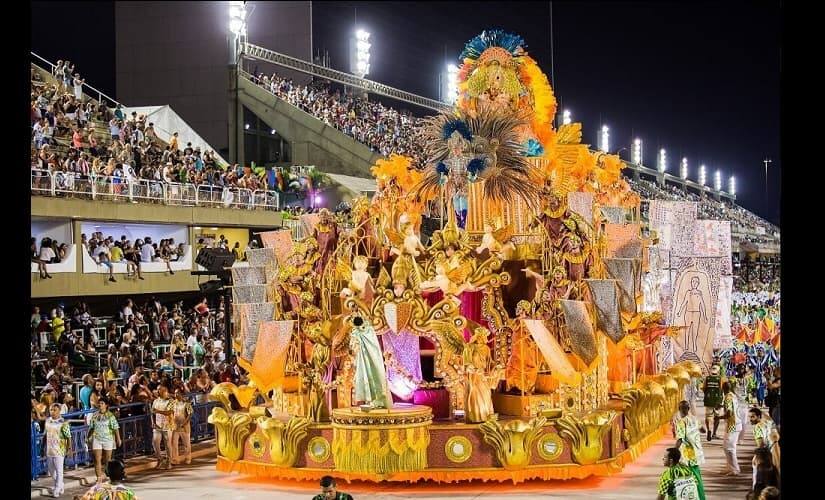Valentine’s Day brings to mind visions of heart-shaped candy boxes, stuffed animals, and roses. Greeting card companies can anticipate a bump in sales, and restaurants witness a similar spike in dinner reservations (preferably of the candle-lit variety). However, not everyone turns to roses and chocolates to declare their love. From consuming a plateful of black noodles to exchanging wooden spoons, here are few unusual traditions from around the globe that are followed on 14 February. Denmark [caption id=“attachment_6045521” align=“alignnone” width=“825”] Source: Twitter[/caption] Rather than red roses, white snowdrop pressed flowers are a popular choice on Valentine’s Day in Denmark. Admirers also send the object of their affection a gaekkebrev — a “joking letter” consisting of a funny poem or rhyme — written on intricately cut paper and signed only with anonymous dots. If the receiver can guess who sent the letter, they earn themselves an Easter egg later that year. South Korea South Koreans have a series of traditions for Valentines Day that begin in February and go until April. On Valentine’s Day, 14 February, women give chocolates to men as a sign of love and affection. The favour is returned on 14 March, a holiday known as White Day, when men shower their beloved with lighter-coloured treats, like white chocolate. And for those who don’t have much to celebrate on either of the days, there is 14 April — Black Day. It’s a tradition for singles to mourn their solitary status by eating dark bowls of jajangmyeon, or black bean-paste noodles. Wales [caption id=“attachment_6045821” align=“alignnone” width=“825”]
 In Wales, men traditionally carved wooden “love spoons” for their sweethearts. Few actual examples before the 1800s survive. Source: Twitter[/caption] People in Wales celebrate Saint Dwynwen, the Welsh patron saint of lovers, on 25 January. In the early 17th century, Welsh men craved intricate wooden spoons as a token of affection for the women they loved. Patterns and symbols were carved into these love spoons, each signifying a different meaning. Today, love spoons are also exchanged during births, weddings and anniversaries. Brazil [caption id=“attachment_6046061” align=“alignnone” width=“825”]
In Wales, men traditionally carved wooden “love spoons” for their sweethearts. Few actual examples before the 1800s survive. Source: Twitter[/caption] People in Wales celebrate Saint Dwynwen, the Welsh patron saint of lovers, on 25 January. In the early 17th century, Welsh men craved intricate wooden spoons as a token of affection for the women they loved. Patterns and symbols were carved into these love spoons, each signifying a different meaning. Today, love spoons are also exchanged during births, weddings and anniversaries. Brazil [caption id=“attachment_6046061” align=“alignnone” width=“825”] Arguably it is the biggest carnival in the world Source: Twitter[/caption] With the traditional carnival held around February or March each year, Brazilians skip 14 February and celebrate Dia dos Namorados, or “Lovers’ Day,” on 12 June. Brazilians honor St. Anthony, the patron saint of marriage and matchmaking, on 12 June. According to Readers Digest, the night before, single women will write men’s names on pieces of paper then fold them up. In the morning, they pick a slip to reveal their future husbands France [caption id=“attachment_6045601” align=“alignnone” width=“825”]
Arguably it is the biggest carnival in the world Source: Twitter[/caption] With the traditional carnival held around February or March each year, Brazilians skip 14 February and celebrate Dia dos Namorados, or “Lovers’ Day,” on 12 June. Brazilians honor St. Anthony, the patron saint of marriage and matchmaking, on 12 June. According to Readers Digest, the night before, single women will write men’s names on pieces of paper then fold them up. In the morning, they pick a slip to reveal their future husbands France [caption id=“attachment_6045601” align=“alignnone” width=“825”] The popular locks bridge on River Seine in Paris. Source: Twitter[/caption] With a reputation of being one of the most romantic places in the world, France has always celebrated Valentine’s Day, as the ‘Day of lovers.’ A traditional Valentine’s Day event in France was the loterie d’amour, or “drawing for love.” Hopeful singles would line up in houses facing each other and call through the windows until they eventually paired up. Women who weren’t paired would light up a bonfire and burn pictures of men who wronged them, whilst hurling insults. The event became so unruly that the French government eventually banned the tradition all together. South Africa Like many parts of the world South Africa celebrates the day with chocolates, flowers and cards. However, in an unusual way, they wear their hearts on sleeves — literally. Following an old-age Roman festival called Lupercalia (thought to be the predecessor to Valentine’s Day), young girls pin the name of their love on their sleeve for the day.
Valentines Day is not all about roses and chocolates. Here are some unusual traditions from around the world
Advertisement
End of Article


)
)
)
)
)
)
)
)
)



